- Flowers
Flower Bulbs Allium Bulbs Anemones Begonia Tubers Crocus Bulbs Daffodil Bulbs Dahlia Tubers Hyacinth Bulbs Lily Bulbs Tulip Bulbs Woodland Flower Bulbs Other Flower BulbsFlower Plants Annual Bedding Plants Children's Flower Plants Clematis Climbing Plants Cottage Garden Plants Exotic Plants Flowers For Cutting Plants Foliage Plants Greenhouse & Indoor Plants Ground Cover Plants Hanging Basket Plants Lavender PlantsHardy Geraniums Herbaceous Border Plants Heuchera Pansies and Violas Patio Plants Water Plants Window Box Plants Winter Bedding Plants Hydrangea Large impact plants Recommended By Our Experts
- Fruit & Vegetables
- Trees, Shrubs & Ornamentals
- House Plants
- Tool Shed
Garden Tools & Equipment Barrows and Trolleys Garden Solutions Harvesting Plant Supports Seed Sowing Tree Stakes Water Butts Weed Control Hand Tools Secateurs, Snips and Pruners WorkshopGarden Irrigation & Watering Irrigation Kits Water Butts Hoses & Sprays Miscellaneous Fertilisers Plant Pots Hanging Baskets Plant Protection Garden Compost All Compost
- Outdoor Living
Garden Living Barbecues & Firepits Garden Storage Solar Lights & Lighting Fixtures & Ornaments Awnings Sail Shades Garden Clocks Landscaping Lawn Edging PavingPatio Heaters Gas Patio Heaters Electric Patio Heaters Fire Pits, Chimeneas, Fire Baskets Wallmounted/Ceiling Patio Heaters Freestanding/Table Top Patio Heaters Water Features Solar Powered Water Features Mains Powered Water Features Indoor Water Features Outdoor Water FeaturesGarden Furniture Rattan Furniture Parasols Garden Benches Dining Sets Loungers Wooden Furniture Party Tents & Gazebos
- Wild Birds
- Gardening Info
- Special Offers
- • Hydrangea macrophylla (mophead and lacecap hydrangeas)
- • Hydrangea paniculata (large, conical shaped heads)
- • Hydrangea anomala subsp. petiolaris (climbing hydrangea)
- • Hydrangea arborescens (sevenbark)
- • Hydrangea quercifolia (oak-leaved hydrangea)
- • Prior to planting, incorporate generous amounts of organic matter into the soil to provide the best growing conditions.
- • Prepare a hole as deep as the root ball and about twice as wide.
- • Set the plant in the hole and fill it with soil.
- • Water thoroughly.
- • Multiple hydrangeas should be spaced about 3 feet apart.
- • Mulch hydrangea plants each spring with a layer of well-rotted manure or compost to help conserve moisture in the soil.
- • On light, sandy soils scatter a slow-release fertiliser around the base of the plant each spring.
- • Acid soils (with a pH value of less than 5.5) produce blue flowers due to the high availability of aluminium in the soil.
- • Neutral to acid soils produce mauve flowers.
- • Alkaline soils produce pink flowers, as the aluminium becomes gradually less available.
- • White hydrangea flowers are unaffected by soil pH.
Join Our Gardening ClubVan Meuwen Gardening Club
Become a Member
Join our Gardening Club to unlock exciting perks and discounts!
JUST £10 for one year's membership
10% OFF EVERY order placed online £20 worth of Van Meuwen Vouchers Exclusive members only deals Join NowHow to grow hydrangeas
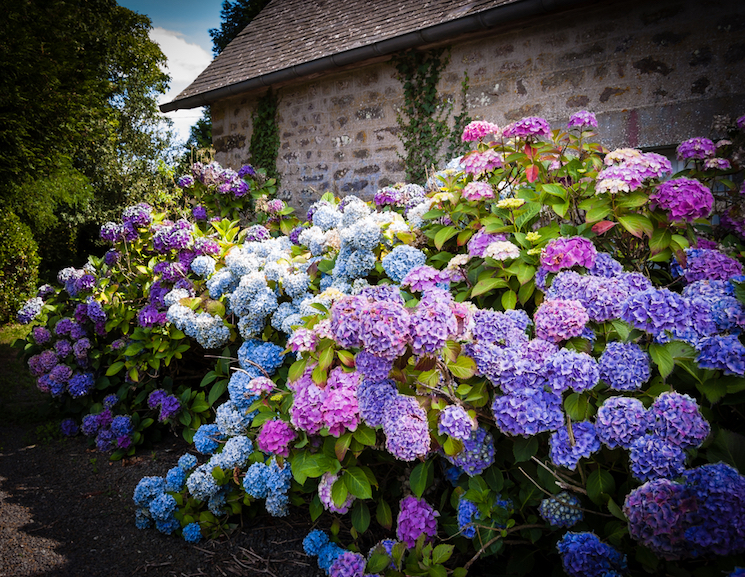
From crisp white through to warm mauve and cool blue, hydrangeas provide an impressive show
Image: ShutterstockWith their large, showy flowers, hydrangea plants are a superb way to bring late-summer colour into your garden. And these stately, elegant shrubs are not only prized for their blooms; many have ornamental flaking bark and attractive autumn-leaf colours too. Read on to find out how to grow hydrangeas in your garden.
Types of hydrangea
The most popular hydrangea varieties you’re likely to see are:
Hydrangea macrophylla
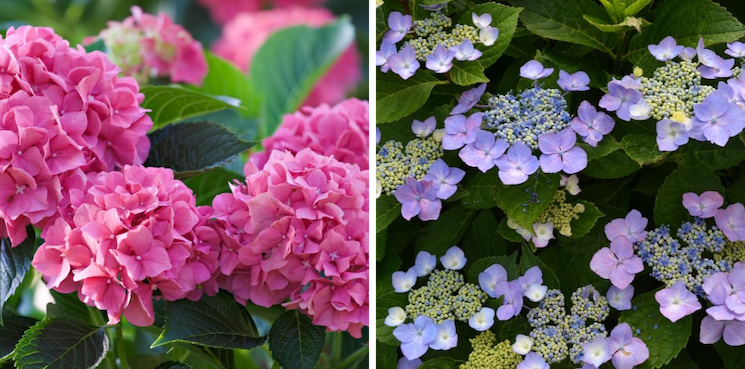
Hydrangea macrophylla include mophead hydrangeas (left) and lacecaps (right)
Image: ShutterstockHydrangea macrophylla is one of the best known hydrangeas. These rounded deciduous shrubs are normally divided into two groups: mopheads and lacecaps. Mopheads (sometimes known as Hortensia) such as Hydrangea 'Glam Rock' have rounded, almost spherical flower heads with mainly large, sterile flowers. Smaller cultivars such as Hydrangea 'Love' (from the same breeder as Hydrangea 'Miss Saori') are ideal for container cultivation.
Lacecaps have flattened flower heads with small fertile flowers in the centre surrounded by large, showy, sterile flowers.
The flowers of Hydrangea macrophylla have the interesting ability to change colour depending on the soil pH. For more information about changing hydrangea colour see the section below.Hydrangea paniculata
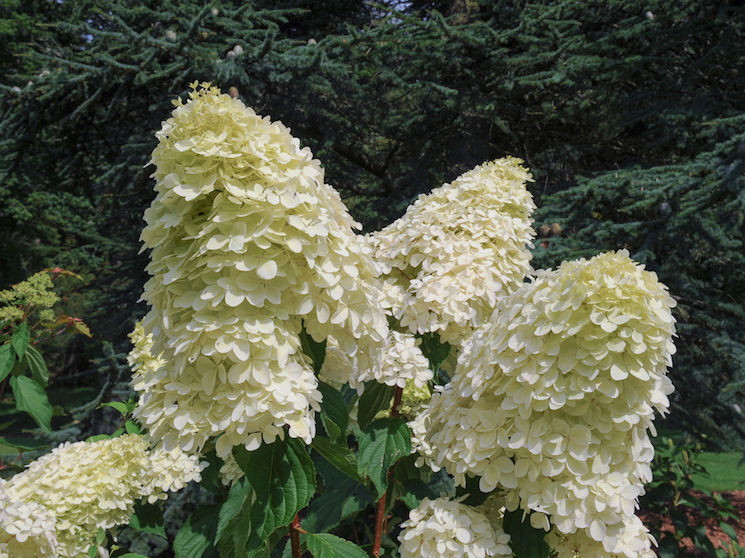
The large, conical flower heads of Hydrangea paniculata
Image: ShutterstockHydrangea paniculata varieties produce large, conical flower heads which often change colour as the season progresses. Varieties such as the stunning Hydrangea 'Vanilla Fraise' are comprised mainly of sterile flowers but some, such as Hydrangea paniculata 'Kyushu', have a mixture of sterile and fertile flowers which are attractive to bees. These tall, upright shrubs are fast growing and form medium to large plants.
Hydrangea anomala subsp. petiolaris
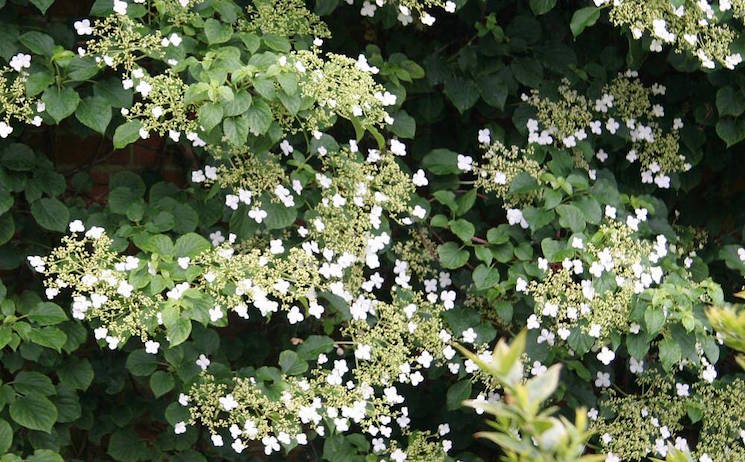
The heart-shaped leaves and lacy, white flowers of Hydrangea petiolaris
Image: Courtesy of Thompson & MorganAlso known as Hydrangea petiolaris, this is the most widely grown of the climbing hydrangea varieties. This vigorous, woody climber thrives in even the shadiest places making it ideal for north-facing walls. Throughout summer, masses of lacy, white hydrangea flowers clothe the stems, attracting bees and other pollinating insects. The heart-shaped leaves turn a glorious butter-yellow in autumn.
Another variety you may come across is Hydrangea seemanii, an evergreen climbing hydrangea which is not fully hardy in the UK, needing some protection in winter.Hydrangea arborescens
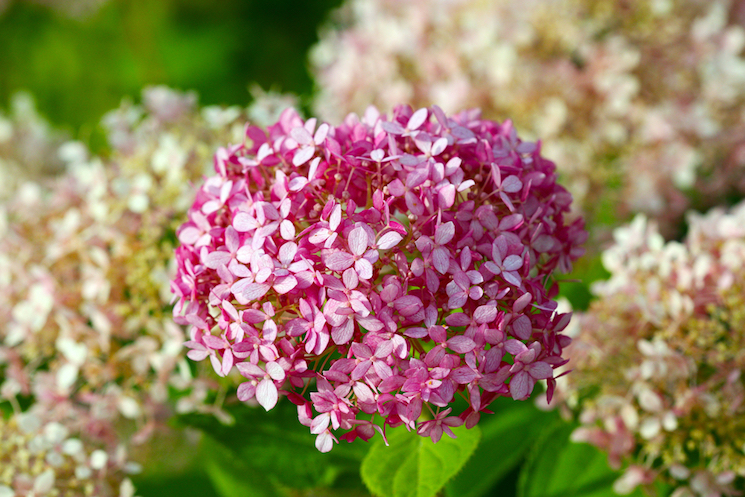
The large, spherical flowerhead of the Hydrangea arborescens Annabelle
Image: ShutterstockAlso known as sevenbark, one of the most popular cultivars is Hydrangea arborescens 'Annabelle'. Producing large, spherical flower heads from July to September these magnificent deciduous shrubs have a good show of autumn colour, when the leaves fade to pale yellow.
Hydrangea quercifolia
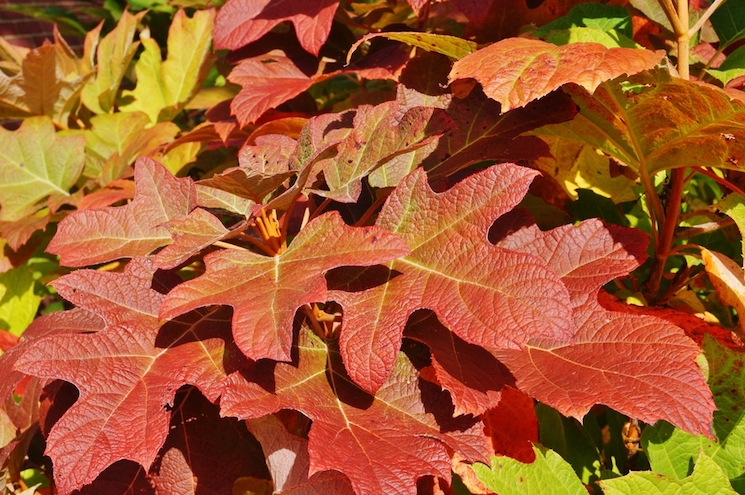
Warm autumnal colours of Hydrangea quercifolia
Image: ShutterstockHydrangea quercifolia – known as the oak-leaved hydrangea – is renowned for its rich autumn colour, when the green, oak-shaped leaves turn to warm, red-bronze shades. A true woodland plant, it prefers at least partial shade.
Where to plant hydrangeas
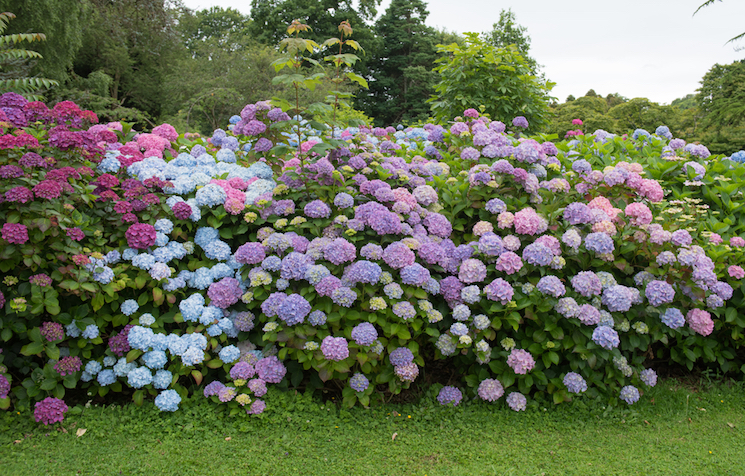
Hydrangeas enjoy the dappled shade of a woodland garden
Image: ShutterstockOriginating from woodland areas, hydrangeas are perfect for cool, dappled shade or woodland gardens. Grow hydrangeas in a partially shaded spot with shelter from cold, drying winds. Avoid dry, sunny spots – hydrangeas can only cope with full sun if their soil is kept moist. Climbing hydrangea (Hydrangea anomala subsp. petiolaris) will happily grow on a shady, north-facing wall.
How to plant hydrangeas
All hydrangeas are heavy drinkers and thrive in moist, fertile soil. They prefer full sun in the morning and dappled shade in the afternoon if possible. Once planted, water at least once a week in the dryer months.
How to grow hydrangeas in pots
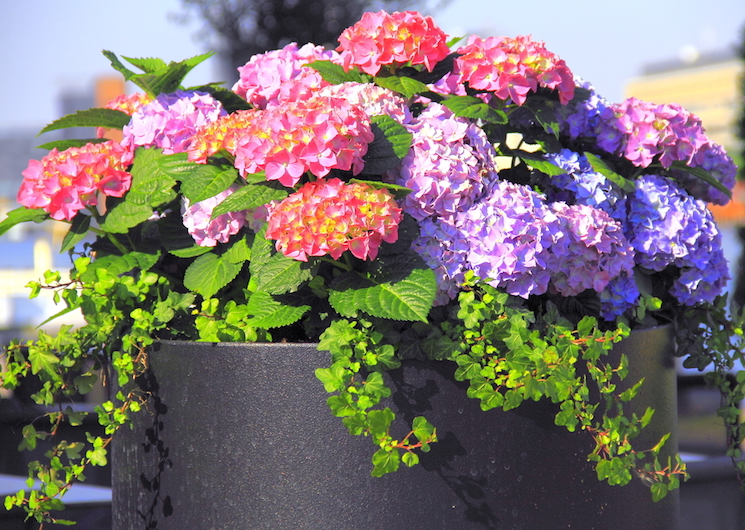
Feed container hydrangeas every few weeks through the growing months
Image: ShutterstockHydrangeas in containers need plenty of water and nutrients throughout the growing season to thrive. Use a container with at least 45cm (18") diameter and depth. Scatter a slow-release fertiliser around the base of the plant in spring or use a balanced liquid fertiliser every few weeks throughout spring and summer. To maintain a blue flower colour use an ericaceous fertiliser.
How to change the colour of a hydrangea
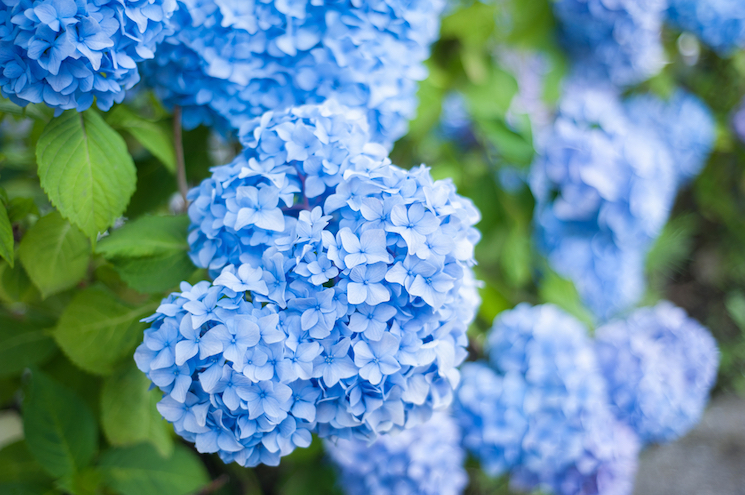
Mophead hydrangeas produce blue flowers in acid soils
Image: ShutterstockSome hydrangea plants, especially cultivars of Hydrangea macrophylla, change flower colour depending on the pH of the soil.
If you have a fairly neutral soil you can apply hydrangea colourants to change the colour of your hydrangea flowers from pink to blue. These compounds contain aluminium sulphate and are readily available online or in garden centres.
You can also try growing hydrangea in pots of ericaceous compost to maintain a blue colour, feeding with ericaceous fertiliser. Ensure you water with rainwater, as hard water contains calcium and magnesium which will create alkaline conditions and cause flowers to become pink over time.How to prune hydrangeas
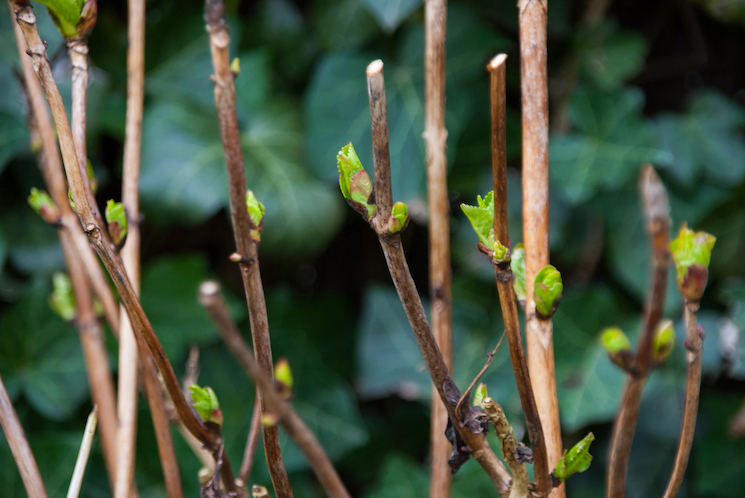
Prune Hydrangea macrophylla back to the first pair of healthy buds
Image: ShutterstockHydrangeas flower on the previous year’s growth and can produce a good display with little pruning. However, regular pruning each year will encourage vigorous new growth and maintain the best display possible.
Pruning shrubby hydrangeas
Hydrangea macrophylla and Hydrangea quercifolia need only light pruning. The dead flower heads of Hydrangea macrophylla should be left on over winter to protect the tender growth buds below. In early spring, remove the dead flower heads, cutting back to the first pair of strong, healthy buds. On established hydrangea plants, cut one or two of the oldest stems back to the base to encourage new, more floriferous growth.
Hydrangea paniculata and Hydrangea arborescens flower more prolifically if pruned back to a permanent framework each spring. Prune the previous year’s stems back to a healthy pair of buds in early spring to maintain this framework. If pruned hard to a low framework, about 25-60cm (10-24") tall, larger flower panicles on strong upright stems will be produced.Pruning climbing hydrangeas
Prune climbing hydrangeas after flowering. Simply remove all spent flowers and cut back any overlong shoots to a pair of healthy buds, so the plant fits the available space. Established plants will tolerate hard pruning in spring but this may sacrifice flowers for a year or two.
That’s everything you need to know about growing and caring for hydrangeas. Follow this guide and your garden will soon be bursting with colour.Quick Links:
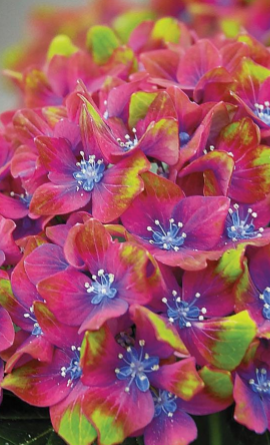
Try our Hydrangea macrophylla 'Glam Rock' for stunning multi-coloured flower heads.
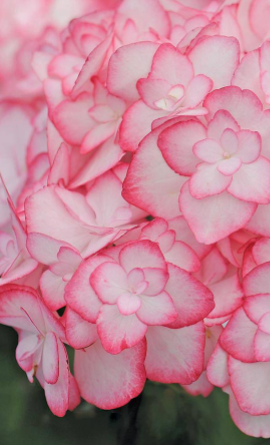
Hydrangea macrophylla 'miss saori': This 2014 Chelsea Flower Show Plant of the Year winner is one of the first of a new kind of Hydrangea that isn't affected by soil type.
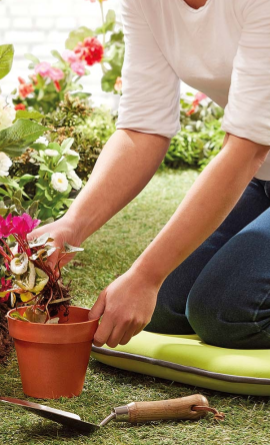
Visit our tool shed for everything you'll need to help your garden grow.
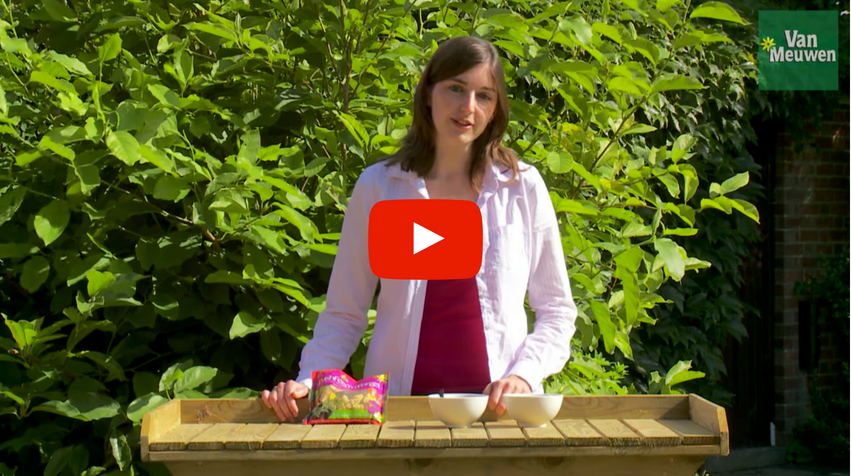
Check out the Van Meuwen video library for expert tips and advice to help you get the best out of your plants, bulbs, and more.

Sign up to the Van Meuwen Gardener's Club for Special Offers
Delivery Information Privacy Policy Cookies Terms of Business Affiliate Programme Planting & Cultural Advice Contact Us© 2024 Van Meuwen. All rights reserved. A division of Branded Garden Products Limited.
- House Plants
